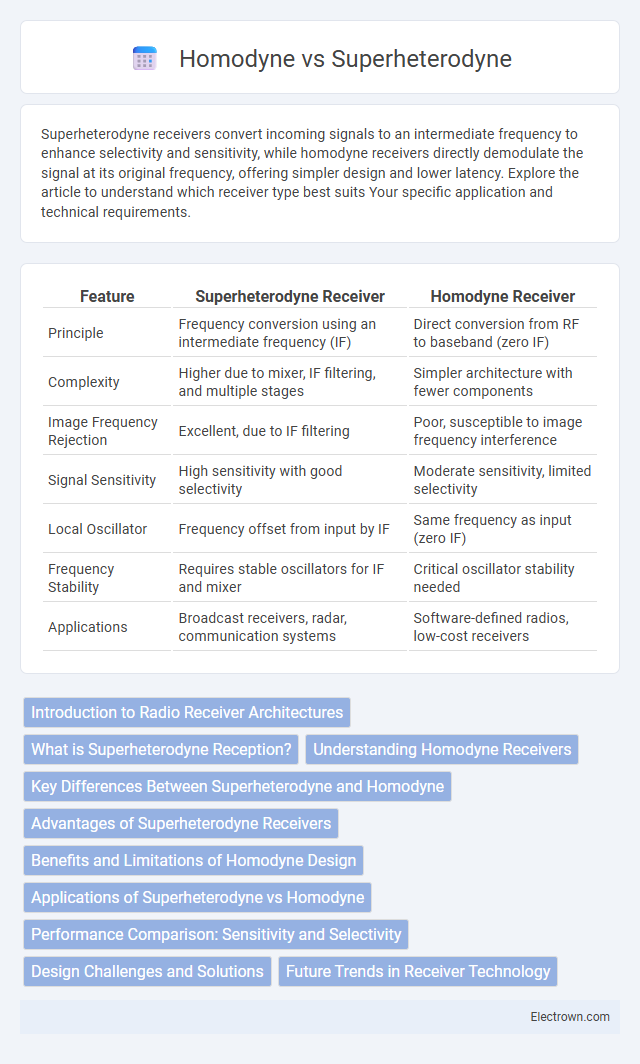Superheterodyne receivers convert incoming signals to an intermediate frequency to enhance selectivity and sensitivity, while homodyne receivers directly demodulate the signal at its original frequency, offering simpler design and lower latency. Explore the article to understand which receiver type best suits Your specific application and technical requirements.
Table of Comparison
| Feature | Superheterodyne Receiver | Homodyne Receiver |
|---|---|---|
| Principle | Frequency conversion using an intermediate frequency (IF) | Direct conversion from RF to baseband (zero IF) |
| Complexity | Higher due to mixer, IF filtering, and multiple stages | Simpler architecture with fewer components |
| Image Frequency Rejection | Excellent, due to IF filtering | Poor, susceptible to image frequency interference |
| Signal Sensitivity | High sensitivity with good selectivity | Moderate sensitivity, limited selectivity |
| Local Oscillator | Frequency offset from input by IF | Same frequency as input (zero IF) |
| Frequency Stability | Requires stable oscillators for IF and mixer | Critical oscillator stability needed |
| Applications | Broadcast receivers, radar, communication systems | Software-defined radios, low-cost receivers |
Introduction to Radio Receiver Architectures
Superheterodyne receivers use frequency conversion to shift the incoming radio signal to an intermediate frequency (IF) for easier processing, enhancing selectivity and sensitivity in complex environments. Homodyne receivers, also known as direct conversion receivers, demodulate the signal at its original frequency, simplifying the architecture but potentially increasing the impact of local oscillator noise and DC offsets. Your choice between these architectures depends on factors like application complexity, performance requirements, and implementation cost.
What is Superheterodyne Reception?
Superheterodyne reception is a radio receiver design that converts the incoming signal frequency to a fixed intermediate frequency (IF) using a local oscillator and mixer, enhancing selectivity and sensitivity. This method improves signal clarity by enabling easier filtering and amplification at the IF stage compared to directly processing the original radio frequency. Your choice of superheterodyne receivers benefits from reduced interference and superior performance in crowded signal environments.
Understanding Homodyne Receivers
Homodyne receivers, also known as zero-IF or direct-conversion receivers, directly convert the received RF signal to baseband without an intermediate frequency, reducing component count and simplifying design. They offer benefits in terms of lower power consumption and improved integration in modern communication systems but face challenges like DC offset and I/Q imbalance. In contrast, superheterodyne receivers use frequency mixing to an intermediate frequency for improved selectivity and sensitivity, making them more suitable for applications demanding high performance.
Key Differences Between Superheterodyne and Homodyne
Superheterodyne receivers convert incoming signals to a lower intermediate frequency (IF) for improved selectivity and sensitivity, while homodyne receivers directly convert the received signal to baseband without an IF stage. Superheterodyne systems typically offer better performance in rejecting image frequencies and interference, making them ideal for high-precision applications. Your choice between superheterodyne and homodyne depends on factors like complexity, cost, and the required signal quality.
Advantages of Superheterodyne Receivers
Superheterodyne receivers offer superior sensitivity and selectivity by converting incoming signals to a fixed intermediate frequency, which allows for more effective filtering and amplification. This design reduces image frequency interference and improves overall frequency stability compared to homodyne receivers. Your communication system benefits from enhanced signal clarity and reduced noise, making superheterodyne technology ideal for complex and high-performance applications.
Benefits and Limitations of Homodyne Design
Homodyne design offers benefits such as simplified circuitry, lower power consumption, and direct conversion from RF to baseband, which reduces intermediate frequency stages and component count. Its limitations include sensitivity to DC offset and flicker noise, complicating accurate signal detection and requiring complex calibration methods. You should consider these trade-offs when choosing between homodyne and superheterodyne architectures for your communication system.
Applications of Superheterodyne vs Homodyne
Superheterodyne receivers are widely used in radio communication systems, television broadcasting, and radar due to their high sensitivity and selectivity in processing weak signals across varying frequencies. Homodyne receivers find applications in coherent optical communication, LIDAR systems, and short-range wireless devices where phase information and simple architecture improve signal detection and demodulation. The choice between superheterodyne and homodyne architectures depends on factors such as frequency stability, complexity, and specific application requirements in telecommunications and sensing technologies.
Performance Comparison: Sensitivity and Selectivity
Superheterodyne receivers offer superior sensitivity by converting signals to an intermediate frequency, allowing effective amplification and filtering, which enhances weak signal detection. Homodyne receivers provide higher selectivity through direct conversion, reducing image frequency issues but often suffer from DC offset and flicker noise that can limit sensitivity. Your choice depends on whether you prioritize sensitivity for weak signal reception or selectivity for precise frequency discrimination in your application.
Design Challenges and Solutions
Superheterodyne receivers face design challenges such as image frequency interference and complex local oscillator requirements, which are addressed through precise filtering and frequency conversion stages. Homodyne receivers encounter issues with DC offsets and I/Q imbalance, mitigated by advanced calibration algorithms and optimized analog front-end components. Your choice between these architectures depends on balancing the complexity of implementing robust filtering in superheterodyne systems against the precision signal processing needed for homodyne receivers.
Future Trends in Receiver Technology
Future trends in receiver technology emphasize enhanced integration and power efficiency, with superheterodyne receivers evolving through software-defined radio (SDR) implementations for dynamic frequency selection and interference mitigation. Homodyne receivers are gaining traction in applications requiring compact, low-power designs, such as IoT devices and wearable technology, due to their simplified architecture and reduced component count. Advancements in semiconductor fabrication and digital signal processing continue to blur the lines between superheterodyne and homodyne architectures, enabling hybrid solutions that capitalize on the strengths of both technologies for next-generation wireless communication systems.
Superheterodyne vs homodyne Infographic

 electrown.com
electrown.com